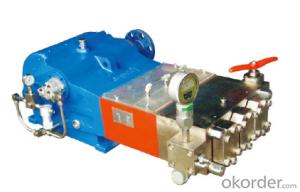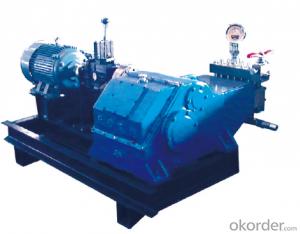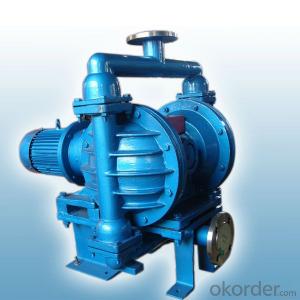3D5-S Type Large Flow High Pressure Plunger Pump
- Loading Port:
- Tianjin
- Payment Terms:
- TT OR LC
- Min Order Qty:
- 1 set
- Supply Capability:
- 100 set/month
OKorder Service Pledge
OKorder Financial Service
You Might Also Like
It is our updated product with the characteristics of small body, samll weight, and the small power for the large flow. The power is only 11-30kw, but the flow can reach 185L/min. It can be equipped with diesel, water tank, high-pressure rubber hose(100m), low pressure water tube, spraying gun, roll, dhassis, wheel and drawing rod forming a washing system, the pushing force of whihc can reach 210N. It is applied for the water cleaning of the pipes at the narrow space such as restaurant, hotel, residential building, municipal sanitation, workshops and so on. The cleaned pipes may be 700mm of diameter and 100mm of length. It is not only for transmission of clear water and emulsification liquid, but also for the transmission of the chemical liquid.


Our company is the drafting company of the Chinese high pressure pump Industry Standard.
Our products have a wide range of applications, such as
1. Industrial pipe cleaning
2.Shipyard rust removal, paint removal
4.Aviation: expansion joints, grease, rubber and hydraulic fluid on runways cleaning.
5.hydropower station/ dam/dike concrete work treating.
6.Casting clean scale removal rust removal paint, removal sand.
7. Pipe pressure test, hose pressure test, hydro pressure test, etc.
Our company has passed European CE Certificate, ISO9001:2000 certificate,ISO 14001:2004 certificate, and AAA Credit Rating Certificate. It’s a member of Waterjet Technology Association (WJTA) in USA and National Standarlization
- Q: What are the common applications of an air pump?
- Air pumps have a wide range of applications in various industries and everyday life. One of the most common applications is in inflating tires, whether it be for bicycles, cars, or other vehicles. Air pumps are also used in sports equipment, such as basketballs, soccer balls, and volleyballs, as well as inflatable toys and air mattresses. In the medical field, air pumps are essential for oxygen therapy, where they deliver a continuous flow of air or oxygen to patients who require respiratory support. These pumps are also used in medical devices like nebulizers, which convert liquid medication into a fine mist for inhalation. Aquariums and fish tanks often utilize air pumps to provide oxygen for the fish, promote water circulation, and power various filtration systems. They are also employed in hydroponics systems to deliver oxygen to the plant roots and ensure proper nutrient absorption. Another important application is in wastewater treatment plants, where air pumps are used to aerate water, facilitating the breakdown of organic matter by bacteria. This helps in the removal of pollutants and the maintenance of a healthy ecosystem. Additionally, air pumps are employed in industrial processes that require compressed air, such as pneumatic tools and machinery. They are also utilized in HVAC systems for air conditioning, ventilation, and heating. Overall, the common applications of air pumps span across a wide range of industries, including automotive, sports, medical, aquatics, agriculture, and manufacturing, making them an essential component in various aspects of our daily lives.
- Q: What are the different flow rate options available in air pumps?
- The different flow rate options available in air pumps vary depending on the specific model. However, commonly available flow rate options for air pumps range from low to high, typically measured in liters per minute (LPM) or gallons per hour (GPH). Lower flow rates are often suitable for small aquariums or oxygenation in fish tanks, while higher flow rates are more appropriate for larger tanks or for powering multiple air-powered devices.
- Q: Can an air pump be used for inflatable advertising displays?
- Certainly! An air pump is capable of being utilized for inflatable advertising displays. As a matter of fact, it is one of the most frequently employed techniques for inflating these sorts of exhibits. The purpose of an air pump is to furnish a consistent stream of air, which is crucial in maintaining the inflation and stability of the inflatable advertising display. These pumps are typically lightweight, portable, and user-friendly. They are available in various sizes and capacities, enabling you to select the appropriate pump according to the dimensions of the display. Whether it be a colossal inflatable balloon, a promotional arch, or a custom-designed inflatable, an air pump can swiftly and effectively inflate the advertising display, rendering it an indispensable tool for any inflatable advertising campaign.
- Q: What are the different voltage options available in air pumps?
- The different voltage options available in air pumps typically include 12V DC, 120V AC, and occasionally 240V AC, depending on the specific model and intended use.
- Q: Are air pumps suitable for inflating air loungers?
- Air pumps are a great choice for inflating air loungers. When it comes to inflating air loungers, a significant amount of air is usually required, and using an air pump can make this process much simpler and quicker. Air pumps are specifically designed to efficiently inflate inflatable items, and they usually come equipped with various nozzles that can be attached to different types of valves found on air loungers. This ensures a secure and airtight seal, resulting in a more effective inflation. Additionally, air pumps often offer different settings or adjustable pressure controls, allowing you to customize the firmness of your air lounger. All in all, using an air pump is highly recommended for inflating air loungers as it saves time, effort, and ensures a proper inflation.
- Q: What is the weight and size of a typical air pump?
- The intended use and design of an air pump can cause variations in its weight and size. Take, for instance, a compact and lightweight small handheld air pump commonly used for inflating sports balls or bicycle tires. Such pumps usually weigh around 0.5 to 1 pound (0.2 to 0.45 kilograms) and are designed to be easily carried around. Conversely, larger air pumps used for inflating inflatable boats, air mattresses, or similar items tend to be heavier and bulkier. Their weight can range from 2 to 10 pounds (0.9 to 4.5 kilograms) or even more, depending on the specific model. These pumps are typically larger to facilitate increased airflow and faster inflation. It should be emphasized that these estimations of weight and size are general ranges and may differ among various brands and models of air pumps.
- Q: Can an air pump be used for inflating inflatable playhouses?
- Indeed, inflatable playhouses can be inflated using an air pump. Inflating them with an air pump is widely considered to be one of the most popular and convenient methods. The reason for this is that an air pump can supply a consistent and controlled flow of air, enabling the playhouse to be inflated quickly and efficiently. To guarantee a proper fit and avoid any air leakage, it is essential to utilize an appropriate air pump with the correct nozzle size. Furthermore, certain air pumps offer adjustable pressure settings, which can be advantageous when inflating larger playhouses or adjusting the firmness of the inflatable structure. All in all, opting to use an air pump for inflating inflatable playhouses is a practical and dependabl.
- Q: What is the maximum number of objects an air pump can inflate simultaneously?
- The simultaneous inflation of objects by an air pump is contingent upon various factors, namely the capacity, airflow rate, and size of said objects. Typically, air pumps are specifically designed to inflate one object at a time in order to optimize both airflow and pressure control, thus ensuring that each object is adequately inflated. Nevertheless, it is possible to find air pumps equipped with multiple outlets or nozzles that enable the simultaneous inflation of numerous objects. Furthermore, the number of objects an air pump can inflate simultaneously is also influenced by the size of said objects. In instances where the objects are small and only necessitate minimal airflow, it becomes feasible to inflate several objects concurrently. Conversely, larger objects with higher airflow requirements may restrict the quantity of objects that can be simultaneously inflated. To accurately determine the maximum number of objects that an air pump can safely and effectively inflate at once, it is recommended to consult the manufacturer's specifications or guidelines pertaining to the specific air pump in question.
- Q: My aquarium oxygen pump does not add oxygen. What's the matter?
- The water is pressure, the water pump is low, the flow of the air outlet can not bring the air out of the cylinder. The pump is equipped with high energy to solve the problem.
- Q: How long does an air pump typically last?
- Several factors can affect the lifespan of an air pump, including the brand, quality, frequency of use, and maintenance. A well-maintained air pump typically lasts between 3 and 7 years, on average. However, some high-quality models can surpass this and remain functional for 10 years or more. To extend the lifespan of an air pump, it is crucial to regularly clean it, store it properly, and replace worn-out parts in a timely manner. Additionally, the intended use of the pump, whether for aquariums or inflatables, can impact its longevity. Consulting the manufacturer's guidelines and recommendations is advisable to ensure optimal performance and durability.
Send your message to us
3D5-S Type Large Flow High Pressure Plunger Pump
- Loading Port:
- Tianjin
- Payment Terms:
- TT OR LC
- Min Order Qty:
- 1 set
- Supply Capability:
- 100 set/month
OKorder Service Pledge
OKorder Financial Service
Similar products
Hot products
Hot Searches


























